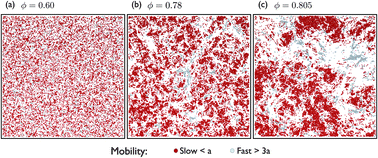Slow and long-ranged dynamical heterogeneities in dissipative fluids
Abstract
A two-dimensional bidisperse granular fluid is shown to exhibit pronounced long-ranged dynamical heterogeneities as dynamical arrest is approached. Here we focus on the most direct approach to study these heterogeneities: we identify clusters of slow particles and determine their size, Nc, and their radius of gyration, RG. We show that  , providing direct evidence that the most immobile particles arrange in fractal objects with a fractal dimension, df, that is observed to increase with packing fraction ϕ. The cluster size distribution obeys scaling, approaching an algebraic decay in the limit of structural arrest, i.e., ϕ → ϕc. Alternatively, dynamical heterogeneities are analyzed via the four-point structure factor S4(q,t) and the dynamical susceptibility χ4(t). S4(q,t) is shown to obey scaling in the full range of packing fractions, 0.6 ≤ ϕ ≤ 0.805, and to become increasingly long-ranged as ϕ → ϕc. Finite size scaling of χ4(t) provides a consistency check for the previously analyzed divergences of χ4(t) ∝ (ϕ − ϕc)−γχ and the correlation length ξ ∝ (ϕ − ϕc)−γξ. We check the robustness of our results with respect to our definition of mobility. The divergences and the scaling for ϕ → ϕc suggest a non-equilibrium glass transition which seems qualitatively independent of the coefficient of restitution.
, providing direct evidence that the most immobile particles arrange in fractal objects with a fractal dimension, df, that is observed to increase with packing fraction ϕ. The cluster size distribution obeys scaling, approaching an algebraic decay in the limit of structural arrest, i.e., ϕ → ϕc. Alternatively, dynamical heterogeneities are analyzed via the four-point structure factor S4(q,t) and the dynamical susceptibility χ4(t). S4(q,t) is shown to obey scaling in the full range of packing fractions, 0.6 ≤ ϕ ≤ 0.805, and to become increasingly long-ranged as ϕ → ϕc. Finite size scaling of χ4(t) provides a consistency check for the previously analyzed divergences of χ4(t) ∝ (ϕ − ϕc)−γχ and the correlation length ξ ∝ (ϕ − ϕc)−γξ. We check the robustness of our results with respect to our definition of mobility. The divergences and the scaling for ϕ → ϕc suggest a non-equilibrium glass transition which seems qualitatively independent of the coefficient of restitution.



 Please wait while we load your content...
Please wait while we load your content...